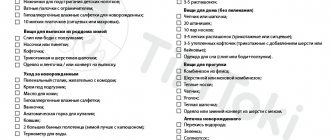When can you start using a sling for newborns and is it harmful to the baby’s health? At what age can he be placed vertically in this carrier? Those mothers who want to purchase and use a sling are interested in the answers to these questions.
Many young mothers are familiar with the situation when a toddler constantly cries, asks to be held and annoys his parents with his whims. Some calmly tolerate such behavior of the baby, while others give up everything they are doing and begin to carry the whining baby in their arms all the time.
Constantly carrying a baby in your arms has a negative impact on a woman’s spine.
Over time, fatigue, pain and discomfort in the back and arms begin to be noted. Buying a carrier made in the form of a sling will help relieve stress on the spinal column and calm an unhappy child. [Hide]
Advantages of slings for newborns
Slings are designed to carry the baby, freeing up mommy's hands and allowing her to do other things. A woman will be able not only to do housework, but also to avoid constant hassle due to a toddler crying in the crib.
The contact of the bodies of mother and child has a beneficial effect on the little one. He develops faster, has the opportunity to explore the world around him and feels the protection and constant care of his mother. For a mother, a sling for newborns allows her to take the load off her back and distribute it evenly throughout her body, relieving her of constant fatigue and pain in the spine.
A sling is an ideal option for both mom and baby. In the carrier, the baby takes the correct physiological position. Children up to six months lie in it, and those toddlers who already know how to sit are in a position where the lower limbs move apart and wrap around the mother’s waist. This position is an excellent prevention of pelvic joint dysplasia.
A sling-type design made of ordinary fabric is actively used by African women. There, mothers carry their children this way all the time. In addition, it should be noted that there is practically no dysplasia in African babies. African children develop much faster than ours, as they have the opportunity to see their surroundings and receive more impressions, emotions and knowledge necessary for accelerated development.
How to use a sling
Correspondence between the stages of development of the spine and the position of the child in the sling:
What can a sling give to a baby?
- body development: the correct curvature of the spine and hip joints is maintained, a muscle corset is formed (since the child reacts to every movement of the mother or father, who wears him in a sling);
- more comfortable digestion: when the baby is positioned vertically in a sling, his tummy is pressed against the mother’s belly, so the resulting heat improves intestinal motility; the legs brought to the stomach help the passage of gases;
- sensory development (hearing, vision, etc.), because when in a sling, a newborn sees much more than when in a stroller; he has the ability to react to the world around him;
- a long stay of a newborn in a sling leads to the formation of a bond with the mother and trust in the world;
- mental development.
Are slings suitable for children with disabilities?
A sling for newborns can also be used to carry those babies who have minor health problems. Now very often babies are born who are diagnosed with increased nervous excitability, which manifests itself in frequent crying, whims and poor sleep. It is almost impossible to calm such children down. They need constant attention from their parents and cannot stay in their crib for long. It is for such babies that a sling is the ideal solution. While in it, the child cuddles up to his mother, this gives him a feeling of relaxation and calm, so he falls asleep faster.
All parents know that in the first months after birth, the child is severely tormented by cramps in the intestines. A sling will help alleviate this condition. While in the carrier, the baby warms up, and the heat acts as a pain reliever, reducing abdominal pain or eliminating it altogether. For this reason, many pediatricians recommend wearing babies in a sling from birth.
The position of the child in the sling depending on his age and type of sling
Preface: This article is about healthy full-term babies and correct physiological slings! Before you start babywearing a premature baby or a baby with health problems, consult with your doctor and an experienced sling consultant!
There are four main types of slings that are most common: the pocket sling, the ring sling, the mai sling, and the scarf sling.
Beginning sling mothers often ask at what age can they wear one or another sling and in what positions. However, the main thing here is not the age of the child and the type of sling, but the experience and ability of the mother to place the child in the correct physiological position. All children are different, all mothers are also different, each with their own unique experience. That is why there are no and cannot be universal instructions for carrying a child only depending on his age. As the child grows and develops, it becomes much easier to place the child in one position or another, but the lack of certain skills is not a categorical ban on their use. This is important: the choice of position for carrying a child depends only on the mother’s ability to position the child in the sling correctly and on the preferences of the child himself, of course.
Physiology
The spine of a healthy person has four curves: cervical, convex forward (lordosis), thoracic, convex backward (kyphosis), lumbar (lordosis), and the fourth curve is formed by the sacrum and coccyx (kyphosis). Normally pronounced curvatures of the spine affect a person’s posture, making it physiologically suitable for upright walking.
The spine of a newborn is a uniform arch convex back - a natural physiological age-related kyphosis (convex bend), which persists during the first 4-6 months. The fabric of the sling allows you to tightly pull the baby's back to you, while maintaining its natural curve. In turn, the smooth, hard surfaces of baby carriers are not able to adapt to the curve of the baby’s back and take the desired shape, and therefore cannot be considered a physiological means for carrying a child.
When the baby begins to raise his head and sit up straight, the 7 upper vertebrae between the upper edge of the spine and the shoulders form the neck, which is strengthened by the forward cervical curve. The next 12 vertebrae, to which the ribs of the chest are attached, continue the curve with their convexity backwards. These are the thoracic vertebrae. When the child begins to stand upright and walk, the next five vertebrae form the lumbar curve with their convexity forward, and the sacrum and coccyx with their convexity backward. During life, the spine constantly undergoes processes of physiological restructuring and adaptation to new environmental conditions and physical activity.
General recommendations: Before mastering this or that position in a sling, it is recommended to first master this position simply in the arms of the mother (of course, except for the back positions). This will not only give the baby the opportunity to get used to the new position, but also help the mother understand exactly how the baby should be positioned.
Horizontal positions in a sling
Horizontal positions (“cradle”) are used from the first days of a baby’s life. You can carry a child in this way as long as he agrees to lie in a sling and this position is comfortable for you (until the end of sling age). Quite often there is a situation when, at one and a half to two months, children begin to prefer vertical carrying, and the need for a horizontal one remains only in cases when you need to feed the baby or put him to bed. This is a normal stage in a child's development: the more interested he is in the world around him, the more he will prefer vertical positions.
The “cradle” in a sling is identical to the horizontal position of a child in the mother’s arms, of course, provided that it is positioned correctly. This means that the baby should be positioned level, with the head approximately at the level of the mother’s chest and in the same plane as the back. If you are not sure about the correct position of the child, compare it with how you hold him in your arms.
You can carry your baby horizontally in a sling-scarf or a sling with rings. For experienced mothers or under the guidance of a sling consultant, you can add a May Sling and a Sling Pocket to this list.
The duration of wearing is regulated by the natural physiological rhythms of the child’s life. If the mother does not drop off the baby, it is necessary to make artificial “breaks”: approximately every hour, take the baby out of the sling and stretch him for several minutes. The younger the child, the more important this rule is: newborns usually sleep statically, without moving. Older children can move and turn in a sling, thereby stretching their muscles on their own.
Some mothers are afraid that in a horizontal position the baby may choke on milk, but these fears are unfounded. Even if the child has “gulped” a lot of milk, he will cough it up. All people, including adults, including healthy ones, periodically inhale particles of sputum containing microorganisms, food debris, etc. However, a healthy baby, like an adult, has a set of mechanisms that prevent aspiration:
cough reflex, spasm of the glottis, bronchi when foreign particles enter there,
cilia on the bronchial mucosa, which wash away foreign particles,
a surfactant system that prevents the lungs from “sticking together” and becoming a breeding ground for anaerobic bacteria,
immune cells on the lung mucosa.
Children with oral abnormalities, swallowing problems and habitual vomiting should be fed in a more upright position, and to avoid the possibility of aspiration from belching, the child should be kept in an upright position or with the head tilted forward for some time after feeding. Breastfeeding in a sling in a horizontal position is not contraindicated for healthy full-term infants.
Vertical positions in a sling
Vertical positions for carrying children are also used from the first days of life. Newborn babies are carried either:
In the fetal position (see 1st picture on the left), starting from 15-20 minutes at a time (on the recommendation of a neurologist and neonatologist) and gradually increasing the duration. This position can be recommended for children with severe hypertension.
In the "frog" position. If the baby does not have strong tone and allows his legs to move outward (2nd picture), it is better to carry him with his legs outward.
The German school of babywearing recommends this type of leg separation from birth, as it is an excellent prevention of the development of hip dysplasia. This is a congenital disease; in Russia it is recorded in 5-6% of newborns. Russian orthopedists agree that this position allows you to correct the incorrect development of the hip joints and will not subsequently require the application of splints and spacers. In the position with the legs facing out, the load is distributed more physiologically and there is no pressure on the baby’s feet.
Most mothers find it difficult to feed their newborn in an upright position, so it is better to initially feed in the “cradle” position, gradually learning to feed vertically. As a rule, by two to three months of a baby’s life, when he is already more or less confidently holding his head, feeding vertically becomes much easier, and for some mothers even earlier.
Many mothers fear that in vertical positions the child’s pelvis experiences a so-called “sedentary” load. However, this is not the case (provided the baby is positioned correctly). The arrows in the photo show how the load is distributed in the sling.
The vertical load on the spine comes from top to bottom and is compensated by the tight attraction of the baby's back to the mother (just like you hold the baby in your arms). After the imaginary line of the level of the baby’s knees is reached, the pressure goes to the sides, since the level of the knees is higher than the butt. Thus, the load is completely removed from the pelvic area. Only slings and physiological backpacks can ensure proper distribution of the load on the baby’s spine and pelvis.
Please note that in this position, the lower side of the sling should pass under the child’s knees, his butt should “sink” into the fabric pocket, and his knees should be located above his butt. The baby's back should be tightly pulled by the fabric towards the mother, while the arms can be either outside or inside the sling, depending on the age and desire of the baby. Not even the most sophisticated kangaroo can provide such a position.
It is important to fix the baby's head in an upright position if he cannot hold it independently. You can support it with one hand, pull it with the fabric of the sling, or put a small soft cushion under the neck (from the back).
Vertical position in front, on mother’s stomach:
This position is possible from the first days of a child’s life: the child should be positioned symmetrically and pressed tightly against the mother, without dangling in the sling. The head must either be secured with the edge of the sling or supported with your hands. In the “frog” position, the legs are fixed with the edge of the sling under the knees, the baby’s butt seems to “sink” into the pocket made of the sling’s fabric, the baby’s knees should be higher than the butt, and the feet should “look” in different directions.
Vertical position on the hip:
Russian sling consultants recommend carrying a baby on your hip from about three months of age. The German school of babywearing “allows” this position from birth. Let's figure out what the difference is.
The vertical position of the child on the hip should be exactly the same as in front, on the mother’s stomach: that is, symmetrical, with the legs spread apart and the head fixed, if the child is not already holding it. But on the hip it is usually more difficult to fix the newborn’s head in the desired position. Not every sling and not every wrap (scarf) will provide adequate support for the baby's head. It is this circumstance that justifies the advice about carrying a child on the hip from three months: at this age, the vast majority of babies confidently hold their head and there is no need to fix it. In addition, the mother is not exactly the same in front and behind: she has breasts in front, and a butt in the back :), so maintaining a symmetrical position of the child is also somewhat more difficult, especially if the mother moves at the same time. Maintaining symmetry is important, as it ensures the uniform development of the child’s muscle corset. When the child's back is stronger, the task becomes much easier.
Thus, you can carry a child on your hip when you can ensure that the baby maintains vertical symmetry and fixes his head (if the child does not hold it).
Vertical position on the back:
This is one of the most difficult positions for beginners in slings, and getting it behind the back becomes easier in direct proportion to the child’s age: the older the baby, the easier it is to tie it behind the back. You can also carry it in a dorsal position from the first days of life, but this is inconvenient because, firstly, it is quite difficult to wrap a newborn on your back, and secondly, it is not possible to feed the baby on your back. However, this provision becomes especially relevant in the case of the birth of twins: after feeding, the mother can tie the calmest baby behind her back and take care of the more demanding toddler. To wrap and tie a newborn on the back, mothers, as a rule, need help: do not hesitate to ask for it (husband, grandparents) until you can freely and confidently tie the baby behind the back. When a child can independently support his head and back, sitting the baby behind his back becomes much easier.
As in other vertical positions, it is important to position the child symmetrically, the head is fixed if necessary.
The most comfortable slings for wearing on the back are a long and short sling scarf. They clearly fix the child, while allowing you to adjust the winding height. Well, besides, the scarf allows you to use a large number of different winding methods and find the most comfortable one for yourself. The May Sling is a little less convenient for wearing on the back, but is also quite comfortable. And the least comfortable sling backpack is: the child sits low in it, has a more limited view, and the load on the carrier is not distributed as comfortably.
Carrying it on the back is very convenient at home when the child has grown a little: he is interested in what the mother is doing, but it is not always convenient for her, for example, to cook if the child is sitting in front. The back position allows the child to observe what the mother is doing, and at the same time protects him from possible dangers: he cannot reach hot pots or sharp objects. In addition, children who have already learned to walk often like to ride behind them. Sitting on mom's back, they get the widest possible view and at the same time can, if necessary, sleep on mom's back. Source
Pros and cons of slings
Using slings has the following advantages:
- Mom's hands are freed;
- The baby is always visible and calm;
- He is in a physiologically correct position;
- The child has a broader overview and better perception of the world around him;
- Improved well-being (elimination of colic) and a beneficial effect on the central nervous system.
Slings also have their disadvantages. Despite the fact that the load on the spine is distributed evenly, it is still there, due to the fact that the muscular corset of the back is under constant tension while wearing the carrier. However, exercises and massage can easily eliminate this deficiency.
Sling scarf for newborn
It is a piece of fabric measuring up to 0.7x6 meters. This type of carrying assumes a symmetrical position. There is no need to alternate shoulders here; you can use all the basic windings. The load is distributed evenly across the shoulders, back, and hips.
Knitted slings-scarves
For the smallest children, you need to use knitted slings-scarves, because they stretch, unlike woven ones, which do not stretch either in width or in length. Knitted slings are created not on looms, but on knitting machines. They are intended for newborns and premature babies.
The older the baby gets, the heavier it becomes. The heavier the child, the more the knitted fabric stretches, sagging under the weight of the baby.
A knitted sling involves a winding called a “cross under a pocket”: the carrier is put on the mother completely tightly and the baby is placed in the finished winding. If we need to get the baby out, we take him out, the sling remains on the mother, there is no need to rewind.
In summer it is hot in a knitted sling, because it is stuffy. Woven fabric allows air to pass through much better.
Types of slings for newborns
There are three types of slings, each with its own characteristics and can be used from birth to four months and from four months to two years.
Sling ring
These carriers are popular among modern young mothers due to their design convenience and ease of putting on. A sling is a piece of fabric, at one end of which there are rings that act as a kind of fasteners. The child can sit or lie down in the carrier. And if such a need arises, the baby can be easily breastfed without anyone noticing. If the little one falls asleep in the sling, you can carefully move him to the crib without waking him up.
This type of sling also has a significant disadvantage for the mother. It can only be attached to one shoulder, so over time the woman begins to feel muscle pain and severe fatigue. To avoid this, the sling needs to be moved from one shoulder to the other from time to time. This is useful not only for the mother, but also for the little one, who also gets tired of constantly lying in one position. When the baby turns four months old, it will be difficult to wear him this way; in this case, the sling ring can be replaced with a sling scarf.
Sling scarf
He is not so popular in our country, but Western women love him very much. It is a long piece of fabric that should be wrapped in a special way around the child and his mother’s waist. Many mothers don’t like it because it takes too long and is inconvenient to tie, and besides, the loose ends hang and dangle when walking. However, if you learn how to tie it correctly, it will become an indispensable thing for moving your little one without a stroller and carrying him in your arms. Using a scarf you can evenly distribute the load on your shoulders, hips and back. The baby can be placed in the carrier from the front, back or side. In addition, he can be in a sling in a lying or sitting position.
The disadvantages of the scarf include the long and difficult tying of it, as well as the impossibility of moving the baby into the crib without waking him up. Pediatricians advise against carrying newborn babies in slings for too long. A few hours a day will be enough, after which the little one needs to be put into a crib. The sling scarf is ideal for children aged four months and older. It can be used for short walks around the city, for trips to the store and clinic. It should be noted that children who cannot yet sit independently should not be placed vertically in a sling, as this can cause serious harm to the fragile spine.
May-sling
The latter are represented by a rectangular pouch with straps, which is tied around the mother's shoulders and waist. Its straps can be crossed on the back or left uncrossed. In such a carrier, the baby is positioned vertically in a sitting position, but at the same time his legs are spread apart in a frog position, and his butt is located below knee level. The inconvenience of this design lies in the impossibility of transferring a sleeping toddler to the crib without waking him up, as well as the impossibility of placing the child horizontally.
Until what age should I wear it?
Fathers and mothers who have recently become parents are sincerely confident that once the child reaches the age of one year, when he learns to walk confidently, there will be no need to carry him in his arms at all, at most, to hug or feel sorry for him. However, in practice this is absolutely not the case.
A baby taking his first steps takes few of them and is not always confident, let alone walking long distances, for example, from home to a playground or store. If there is no stroller or carrier at hand, then the walker confidently makes this way... in the arms of mom or dad, because they get tired quickly. Agree that carrying a child in a sling even to the store will be much easier than just in your arms.
As practice shows, a sling for long-term wearing (for example, for a walk, where the child will sleep) will be relevant for up to 1.5-2 years, and then it will be useful for occasional use (in certain situations - for example, on a trip or on a hike, during shopping, etc.) or short-term wearing for up to three years, and sometimes more.
Age limit
Pediatricians recommend purchasing a sling based on the toddler’s age. Unfortunately, a universal carrier has not yet been invented. Those slings that are suitable for newborn babies are not suitable for more active, older babies.
At what age is it best to start using a sling? When can a child be placed in an upright position in a carrier? Slings are allowed to be used from birth, but they have a number of their own features. Using the recommendations below for selecting a sling for the toddler’s age, it can be used correctly without fear of harming the fragile child’s body.
Sling for newborns from 0 to 4 months
During the newborn period, the baby's spinal column is not yet strong, and the muscular system is in the process of formation. For this reason, the newborn baby should be in a horizontal position so that his head and neck are clearly fixed, and the mother’s hand supports the baby under the back. This rule is extremely important to follow, especially if the child will be in it for a long time.
It is prohibited to carry babies in a sling in an upright position. A ring sling is ideal for this age. With its help, the baby's posture can be precisely adjusted and secured in the desired position.
Sling for newborns from 4 months
At the age of four months, the baby can independently roll over onto his stomach and hold his head up. Therefore, it can be placed in a sling vertically or in a sitting position. To carry four-month-old babies, you can use both scarf slings and baby slings.
Since toddlers at this age begin to become more active, it is best to use a sling scarf. It does not hinder the child’s movements, allows him to better see the surrounding environment and follow the mother’s facial expression, capturing all her emotions. In addition, being in a sling is much more interesting for a child than lying in a stroller and looking into the hood or into the sky.
Sling for newborns from 7 months
When your baby reaches seven months, you can use both a sling scarf and a backpack, which is an excellent alternative to a sling.
At seven months, the baby is already sitting well and trying to take the first steps by standing on its feet, so the best position for carrying it will be a vertical position. A simple and easy-to-use ergo backpack can provide this. These carriers are more popular with dads, who happily carry their babies in them. However, in comparison with scarf slings, backpacks have the disadvantage of hard foam sides that do not allow air to pass through. For this reason, the little one will be hot in such a carrier. And since children have a poorly established thermoregulation mechanism, it is not recommended to use ergo backpacks in the summer. They are best used in autumn or spring. And for winter, leave the stroller, since a child dressed in thick winter overalls is not as easy to carry on his back or chest as in light summer or spring clothes.
May-sling and fast-sling
This is a fast and easy to learn sling. Typically, a May Sling is used from 3-4 months, but some designs are suitable for children from birth. Summer has arrived, it has become hot, and you realize that the scarf sling has thick, warm fabric. When it is already 20-25 degrees outside, it is recommended to use a thin and light May-sling: it will be ventilated and not at all hot in it.
My-sling is structurally different from a scarf-sling: it is more rigid, and the child already feels differently in it.
The baby may have an adaptation period: he will cry or break out. But gradually both mother and child get used to it, receiving only pleasure from using it. The fabric of May- and Fast-slings is very durable; they are designed to bear quite a lot of weight.
How to wear a sling with rings, video
How to put on a ring sling correctly so that you can feel all its benefits? It's very simple. This type of sling is easiest to tie, since it is moderately long and has an auxiliary device in the form of a ring.
- Place the end of the fabric with the ring on your shoulder.
- Pass the second edge of the product through the ring and bring it to the back.
- Thread the edge of the fabric through the rings again and bring it forward.
- Straighten the folds of the pocket that should have formed in front of you.
- Place your baby there, and then tighten the fabric so that the baby is tightly connected to you and does not dangle in the sling.
Make sure that the fabric on the shoulder is also straightened. That way she won't put pressure.
You can tie a sling with rings for newborns in another way. You don't have to do this on yourself. Just thread the tail through the rings without wearing the product. Secure everything well. Then put the sling on yourself and straighten it well so that both you and the baby are comfortable. After this, adjust the sizes by tightening or loosening the fabric.
Tying the garment correctly is only half the battle. It is also important to know how to wear a ring sling correctly. You will learn about this in the next section.










